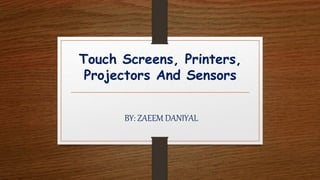
Touch-screens, printers, projectors and sensors
- 1. Touch Screens, Printers, Projectors And Sensors BY: ZAEEM DANIYAL
- 3. Input devices: o An input device for a computer allows you to enter information. Input Devices: Cameras Trackballs Barcode reader Digital camera Touch-screens Keyboard Microphone Mouse (pointing device) Scanner Sensors Touch-pens
- 4. Output devices are pieces of hardware that process data sent from a computer and translate it into a form readable by humans. Output Devices : Monitors Printers Speakers Plotters Projectors Computer output microfilm Sound cards Headphones
- 5. Touch-screen technology is the direct manipulation type gesture based technology. Direct manipulation is the ability to manipulate digital world inside a screen without the use of command-line-commands. A device which works on touch-screen technology is coined as Touch-screen. A touch-screen is an electronic visual display capable of ‘detecting’ and effectively ‘locating’ a touch over its display area. It is sensitive to the touch of a human finger, hand, pointed finger nail and passive objects like stylus. Users can simply move things on the screen, scroll them, make them bigger and many more.
- 6. TYPES:
- 7. A sensor is a device that detects and responds to some type of input from the physical environment. The specific input could be light, heat, motion, moisture, pressure, or any one of a great number of other environmental phenomena. The output is generally a signal that is converted to human- readable display at the sensor location or transmitted electronically over a network for reading or further processing.
- 8. Here are a few examples of the many different types of sensors: In a mercury-based glass thermometer, the input is temperature. The liquid contained expands and contracts in response, causing the level to be higher or lower on the marked gauge, which is human-readable. An oxygen sensor in a car's emission control system detects the gasoline/oxygen ratio, usually through a chemical reaction that generates a voltage. A computer in the engine reads the voltage and, if the mixture is not optimal, re-adjusts the balance. Motion sensors in various systems including home security lights, automatic doors and bathroom fixtures typically send out some type of energy, such as microwaves, ultrasonic waves or light beams and detect when the flow of energy is interrupted by something entering it’s path. A photosensor detects the presence of visible light, infrared transmission (IR), and/or ultra-violet (UV) energy.
- 9. Printer is a peripheral which makes a persistent human-readable representation of graphics or text on paper or similar physical media.
- 10. There are many different types of printers. In terms of the technology utilized, printers fall into the following categories: • Daisy-wheel: Similar to a ball-head typewriter, this type of printer has a plastic or metal wheel on which the shape of each character stands out in relief. A hammer presses the wheel against a ribbon, which in turn makes an ink stain in the shape of the character on the paper. Daisy-wheel printers produce letter-quality print but cannot print graphics.
- 11. Dot-matrix: Creates characters by striking pins against an ink ribbon. Each pin makes a dot, and combinations of dots form characters and illustrations.
- 12. Laser: Uses the same technology as copy machines. Laser printers produce very high quality text and graphics.
- 13. LCD & LED :Similar to a laser printer, but uses liquid crystals or light-emitting diodes rather than a laser to produce an image on the drum.
- 14. Line printer: Contains a chain of characters or pins that print an entire line at one time. Line printers are very fast, but produce low-quality print.
- 15. Thermal printer: An inexpensive printer that works by pushing heated pins against heat- sensitive paper. Thermal printers are widely used in calculators and fax machines.
- 16. A projector is a device that uses light and lenses to take an image and project a magnified image onto a larger screen or wall. Projectors can magnify still or moving images depending on how they are built. The image must be shone through a sealed tube or frame when passing through the lenses to maintain focus. BENEFITS: Still and video projectors are used by both business and educational institutions to showcase important presentations and videos. Movie theaters to this day use projectors to show films on a large screen.
- 17. 1) DLP Projection: DLP technology is based on an optical semiconductor called a DMD chip (Digital Micro-mirror Device), which was invented in 1987 by Texas Instruments (can’t remember the guys name). The way it works is that a DMD chip is made up of millions of tiny mirrors, that can rotate at a 10 degrees angle (12 degrees on better models). These mirrors are literally capable of switching on and off thousands of times per second and are used to direct light towards and away from a dedicated pixel space. The length of time a pixel is on/off determines the level of gray seen in the pixel. Completely on is lightest (white) and off is darkest (black), although neither are ever pure white or black. The current DMD chips can produce 1024 shades of grey. However, color is still to be added. TYPES:
- 18. 2) LCD Projection: LCD Projection is by far the cheaper method of getting great home cinema. LCD (liquid crystal display) projectors contain three separate LCD glass panels, one for red, green, and blue components of the image signal being transferred to the projector. As the light passes through the LCD panels, individual pixels can be opened to allow light to pass or closed to block the light. This activity modulates the light and produces the image that is projected onto the screen.